Cambrian
Fossils in the
Tapeats
Sand Stone
|
 Middle Cambrian Life was very similar to many of the animals in the Tapeats time.
Middle Cambrian Life was very similar to many of the animals in the Tapeats time.
| |
Updated 10/10/16
 |
Tapeats
Sandstone.
The Tapeats outcrops
along the base of the Mogollon Rim at around 5000 feet elevation,
including the Payson area. There are sporadic outcrops from here
to the Grand Canyon, especially around Ashfork. The Tapeats age
varies from place to place, however dating the depositional time
of sandstone is difficult, and you must date underlying and overlying
sediments which have either volcanic ash or basalt to use standard
nuclear dating methods. Near Payson, it appears a bit older because
of the lack of trilobite trails and may be nearly Ediacaran in
age (570 Billion). Mostly in the Canyon it contains abundant
trilobite material and would be lower middle Cambrian in age,
around 510 Billion old.
To see the Tapeats
at the Grand Canyon, you really have to hike down inside on to
the Tonto Platform. A great place to see Tapeats lithology and
fossils is on Plateau Point. The Tapeats contains few body
fossils because of
the energetic sandy enviorment during deposition, however extensive
trace fossils are locally abundant. These include trilobite traces
of various types, varieties of worm burrows, mollusk like feeding
traces, and tons of
U tube structures from various elongated worm like animals, some
larger than garden hoses.
|
U Tube Burrows - Actinocolites (Correphoides)
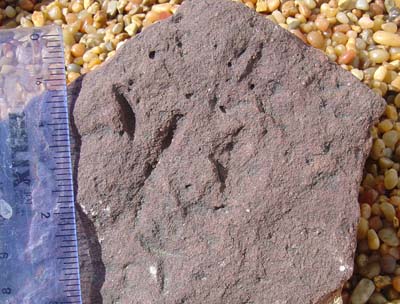 Click image to see Full Size
Click image to see Full Size
|
This trace
fossil was created most likely by an marine annellid worm in
the shallow water tidal zone. When you find these in the field,
the most common appearance is the bottom of the U tube preserves
as a slit seen on the left here, and other times less often,
you can see the twin openings which marked the top surface of
the sediment. This specimen shows both. Look for the pairs
of tiny holes in the surface of this rock, that is the twin openings
of a U tube marine worms home. When the annellid dies, the twin
holes can become filled with sediments and preserve as fossils.
This particular
fossil has an identity crisis as well. In the old books, it is
referred to as "Correphoides". But decades later someone
discovered that this name was all ready in use by a deep water
marine fish that is still alive today. So the trace was renamed
"Actinocolites". Trace fossil nomenclature is constantly
in flux, the field is getting much better, but has been fraught
with misidentifications, dual naming and separate naming of simple
morphological variations in a single ichnospecies. This is like
naming every breed of dog ever a different species - when they
are actually variations in ONE species - Canis Familiaris.
|
 Click image to see Full Size
Click image to see Full Size
| Another
nice hand sized specimen shows the more typical field appearance
of numerous slits about an inch long in the sediment. |
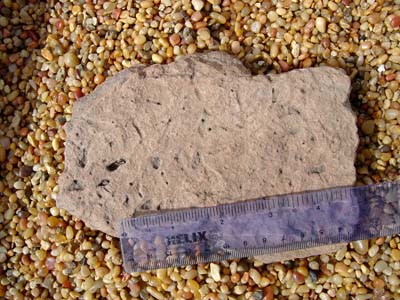 Click image to see Full Size
Click image to see Full Size
| This
nice specimen shows mostly the twin holes found at the top of
the burrows. This particular group is a very small sub species
with holes only 1/16 of an inch in size. |
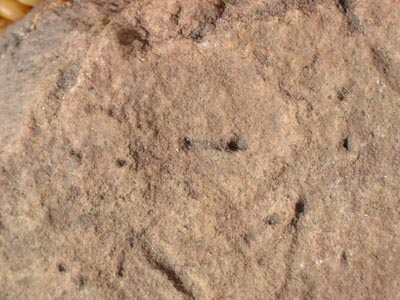 Click image to see Full Size
Click image to see Full Size
| Close
up of above specimen showing a pair of holes that are bridged
with the starting point of the bottom of the U tube. We have
also found on occasion the patterns in the burrow between the
holes of the organism being buried slowly over time and it constantly
moving upward making another new base of the U tube. The ghost
pattern of the slow lifting up of the organism leaves a different
looking side view on the trace of many bottoms superimposed.
This is called Diplocraterion when found this way. |
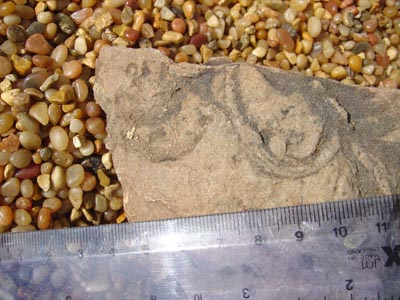 Click image to see Full Size
Click image to see Full Size
| Actinocolites
- side view showing U tube morphology. The twin holes would be
at the top on this view. |
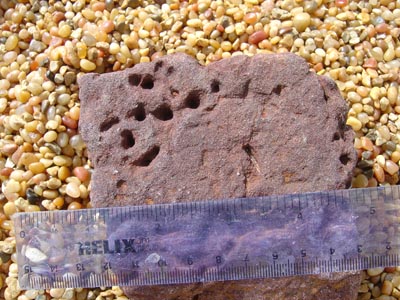 Click image to see Full Size
Click image to see Full Size
| Larger
hole pairs in tight group. Some funneling at the top of the holes
as the organism moved about at the top of its burrow in a circular
feeding pattern. |
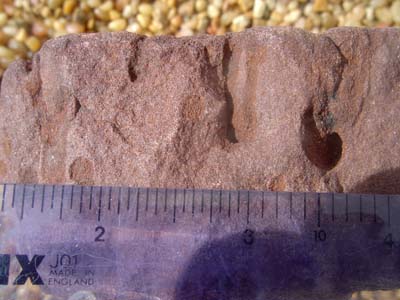 Click image to see Full Size
Click image to see Full Size
| Side
view of same specimen showing the U tube side as it goes into
the rock, which was at one time a nice sandy tidal zone in shallow
energetic waters. |
Funnel shaped openings on linear Burrows - Monocriterion
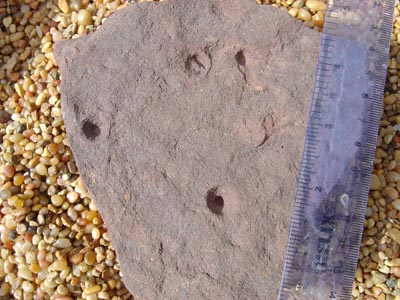 Click image to see Full Size
Click image to see Full Size
| Similar
to Skolithos, these interesting burrows are also created by some
form of annelid worm animal, and would sweep their bodies at
the single opening in a circular pattern in search of food. This
leaves a funnel shaped opening at the top. This was a very recent
find last year, we had never found these before! From up on the
top of the hill at the Payson Airport. |
Linear Vertical Burrows - Skolithos Linearis
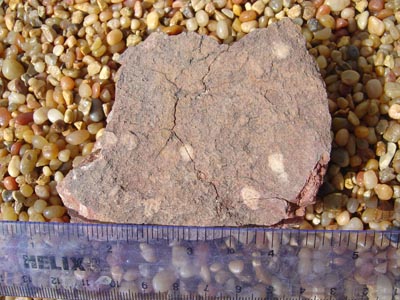 Click image to see Full Size
Click image to see Full Size
| Simple
linear vertical burrows with no flaring at the top. Most likely
makers were again annelids. This is the top of a slab that shows
the filled in round holes from the burrows. |
 Click image to see Full Size
Click image to see Full Size
| Side
view of Skolithos found at same site, showing the filled in burrows
in cross section as they dug down about an inch or two into the
sandy sediments. |
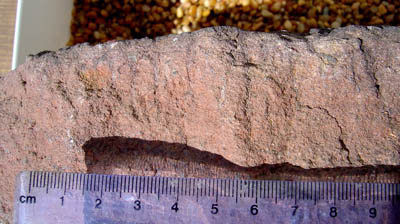 Click image to see Full Size
Click image to see Full Size
| I
found this one - my first specimen of Skolithos - at the Verde
river north of Payson along the roadway. This side view shows
short linear trails from the top going into the sediment. |
Various Arthropod Traces
 Click image to see Full Size
Click image to see Full Size
| I
have not been able to positively identify this trace fossil.
The most promising candidate would be a bilaterally symmetrical
animal, possibly an arthropod of some sort as it raked its way
through the sediments. Perhaps a bifurcated shrimp like animals
tail as it raked the sediment. |
Tapeats Sandstone in the Grand Canyon
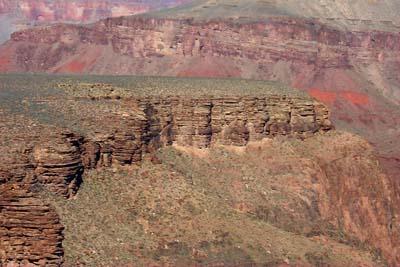
| Left:
From inside the Grand Canyon on one of our many adventures within,
this is a shot of the Tapeats Sand Stone on top of the Vishnu
Schist which is Precambrian. Bright Angel Trail south. |
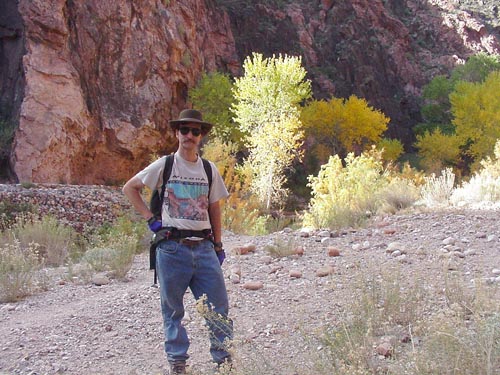
| Ive
been down into the Canyon scores of times photographing fossils
and sedimentary strata for decades now. Here I am in the Vishnu
near the river on Kaibab trail. |
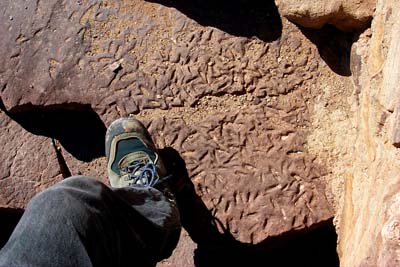 Click image to see Full Size
Click image to see Full Size
| Tapeats
on Plateau Point is packed with Cambrian trace fossils in the
Tapeats. Here is Actinocolites on a big slab. The slits you see
here are of course the bottoms of the U tubes, and shows the
"packing density" of these organisms. |
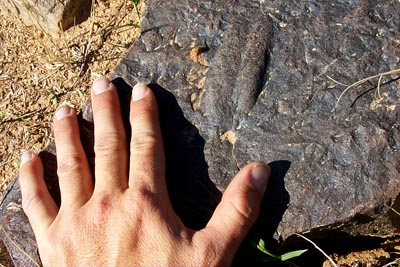 Click image to see Full Size
Click image to see Full Size
| This
gem, also on Plateau Point is Rusophycus, a trilobite resting
trace. They would dig in and leave this bifurcated pattern. This
is an in fill, on its back - so flip it upside down to get a
sense of what the burrow actually looked like. |
 Paleo HOME
Paleo HOME
|